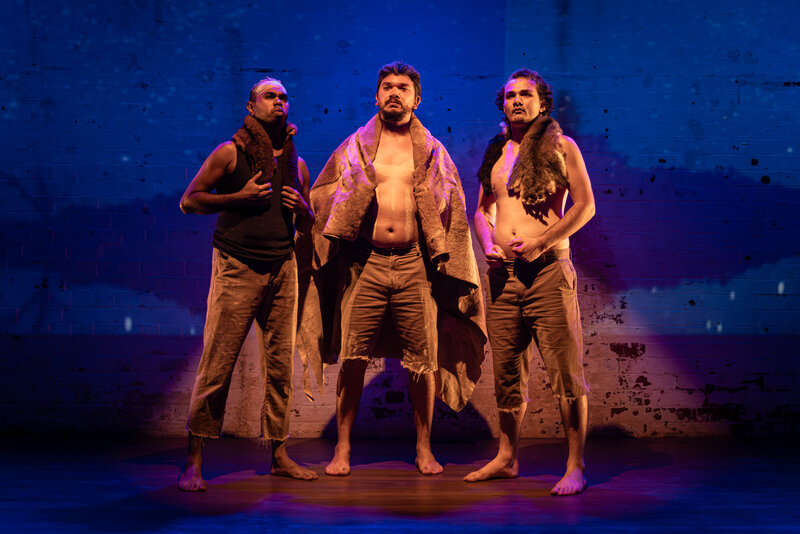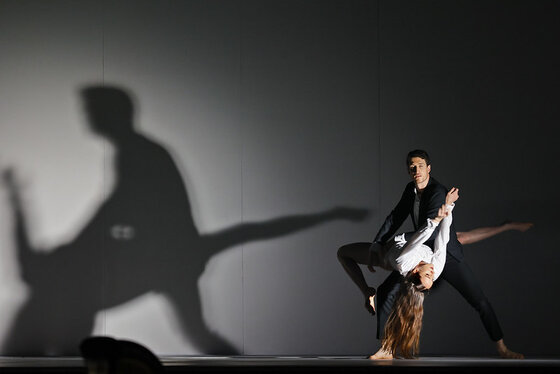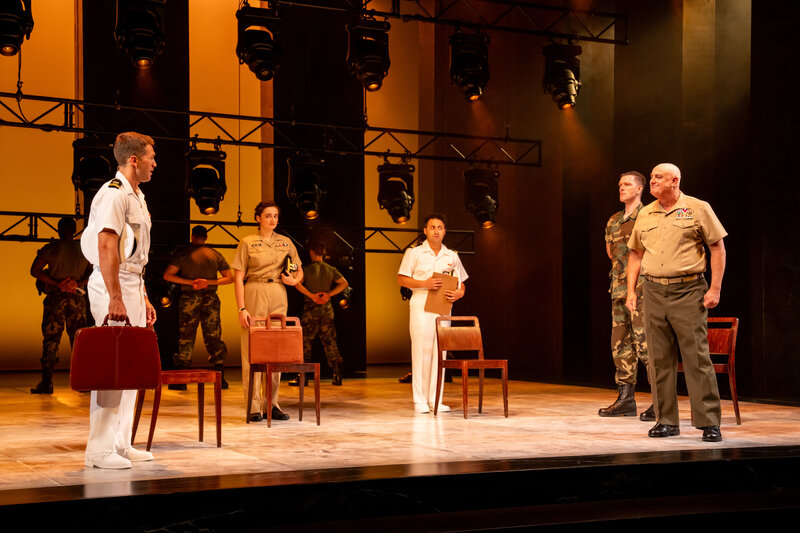– With a bullet hole through your neck, numbskull of yours never looked so fine.
– Rest in peace Daddy numbskull.
– Ta ta Daddy ya sick bundle of shit.
– Bye bye Daddy you misery heap of shit. […] – Girls, I think your father is dead.
– I knocked his knees out.
– I conked his head.
– I shot that house-clown in the neck.
So begins The Bleeding Tree, by Angus Cerini. With a power-house trio of actors: Paula Arundell, Shari Sebbens and Airlie Dodds, Lee Lewis, the director, takes hold of this contemporary Gothic tale of self defence and revenge and hurls it out into the world onto the SBW Stage with a fearsome sense of this is a truth you all may have only dreamt about in the unconscious swirls of your deepest, darkest nightmares, but for some is a wish fulfilment of a lifesaving confrontation. Exaggerated, you think. Not for some, for sure. Spousal abuse, in our contemporary society, at all the social levels of our so-called civilisation, is being dragged out into the light for our conscious gaze, and though we wince, and prefer to avoid acknowledging that it is a much more commonplace possibility than we want, we have to surrender to the old aphorism: where there is smoke, there is fire!
 The Bleeding Tree, is a story told for now, and it sounds and feels like the darkest of the Grimm Brothers tales, and in its writing, is as grotesquely beautiful as Angela Carter (e.g. The Bloody Chamber) at her glittering and haunting best in her twists on the canon of fairytales as lessons for contemplative observation and caution. It comes from the lair of a dry dirt town in rural Australia, a Wolf Creek, perhaps (without the True Detective or Top of the Lake allure of a distant locale like Louisiana or beautiful New Zealand, that had us thrilled but feeling safe in our lounge rooms), that makes this tale anything but fantastical and fabular, but frighteningly real and pulsingly present. Mr Cerini writes in the form of “a murder ballad”, a story theatre form, a poetic narration of the action, to be spoken by three actors who find the right words from the treasure of his ‘poem’ for their impersonations as his storytellers and identified characters.
The Bleeding Tree, is a story told for now, and it sounds and feels like the darkest of the Grimm Brothers tales, and in its writing, is as grotesquely beautiful as Angela Carter (e.g. The Bloody Chamber) at her glittering and haunting best in her twists on the canon of fairytales as lessons for contemplative observation and caution. It comes from the lair of a dry dirt town in rural Australia, a Wolf Creek, perhaps (without the True Detective or Top of the Lake allure of a distant locale like Louisiana or beautiful New Zealand, that had us thrilled but feeling safe in our lounge rooms), that makes this tale anything but fantastical and fabular, but frighteningly real and pulsingly present. Mr Cerini writes in the form of “a murder ballad”, a story theatre form, a poetic narration of the action, to be spoken by three actors who find the right words from the treasure of his ‘poem’ for their impersonations as his storytellers and identified characters.
The play begins with the murder, and so the only issue left is: how to dispose of the body. Surprisingly, the women find the neighbours, the townsfolk, in sympathy with their plight and who, all, assist a cover-up (is it out of collective guilt for their previous inaction?). The body is strung up on the bleeding tree and allowed to rot and be eaten – and we, the audience are taken to a vivid word world of an unruly unconscious grotesquerie shimmering, shivering, with a weird, highly sensual celebration of revenge, decay, and a very rough execution of order being restored. It does not have the restorative glow of the Elizabethan the first, world perspective, that is, a struggling Christian one, but it is certainly reflective of the Elizabethan the second world experience, one of the simplicity of the shattered Christian check and balances of our very own moralities. It is one, perhaps, in theatre literature history terms, that is more Jacobean than Elizabethan. Bloody and decadent in the truth and necessities of the animal reflexes of our present desperate times.
Paula Arundell has been given a role that reveals all of her glowering power of imagination, emotional range and sheer bloody honesty – a courage to reveal an imaginative life that can translate and transcend into a truthful exposure of the darkest depths of human suffering. What was Ms Arundell channeling for us when she ignited into unforgettable moments of incandescence revealing a life grief of venting pain when the postie copper Stevens arrives at the house?
– Ya wanna say something Stevens is it? You want to say something now is it you? All the times you see you knew. His hands like fucking hammers, his fists like molten rain, his fucking mouth and his violence always been the same. But what do you do Stevens? What do you and all them menfolk do? Ya let him. Ya let him do what he do. Ya let him do what he do cos it’s not your business is it Stevens. None of yours is it man. Don’t stick your bloody nose into anybody else’s business that the authorised plan?
Whatever it is, it is a most extraordinary gift from an extraordinary actor for us groundlings, us ordinary folk. It is, truly, a wonder, an Elizabethan/Jacobean wonder. (What would her Mother Courage have been?) Ms Arundell has been a star performer on our stages for years, in mostly, secondary tasks, but now has been given, by Ms Lewis, an opportunity to show us how bright a Sun she is. Let us now be rewarded with further opportunities of her gifts, please.
And surrounding this performance are two shattering ones by Shari Sebbens, growing in stature with every task she has been given (Battle of Waterloo), still, but deep in the plumbing of her emotional dilemmas; and a relative newcomer to our stages, an exciting Airlie Dodd – her character young, unpredictable and tortured by her fears. There is a contagious fever of daring and simpatico between these three actors that is breathlessly thrilling to witness.
 Part of the danger in/of the performance, we absorb, might be because of our unconscious sense of the knife-edge danger these actors maybe experiencing performing on this monstrously precipitous set design by Renee Mulder. This design may be decorated, strewn with a period pattern of wall-paper/lino flowers but it looks anything but safe, and we hold our breath for the actors, even unconsciously, as they negotiate its constant scariness of possible injury. The design, then, does work as an inter-active visceral embodiment of danger for the audience, and the dramatic schemata of Verity Hampson’s lighting must be acknowledged as another creative power of this production to that end, along with the haunting, moving composition, sound design of Steve Toulmin.
Part of the danger in/of the performance, we absorb, might be because of our unconscious sense of the knife-edge danger these actors maybe experiencing performing on this monstrously precipitous set design by Renee Mulder. This design may be decorated, strewn with a period pattern of wall-paper/lino flowers but it looks anything but safe, and we hold our breath for the actors, even unconsciously, as they negotiate its constant scariness of possible injury. The design, then, does work as an inter-active visceral embodiment of danger for the audience, and the dramatic schemata of Verity Hampson’s lighting must be acknowledged as another creative power of this production to that end, along with the haunting, moving composition, sound design of Steve Toulmin.
Lee Lewis has worked with this writing in fine detail, and mounts the tension of the story arc with a laser-like craftsmanship to serve the revelation of the beauty of Mr Cerini’s exotic linguistics and ‘musical’ score. It appears to be a labor of love, and it is an undoubted gift, a reward for her audience.
The Bleeding Tree was the 2014 Griffin Award playwrighting winner. In this production one can truly appreciate its deserving.
Grotesquely beautiful. Morally cauterising. Glorious artistic daring from all. Go.
Company: Griffin Theatre Company
Venue: SBW Stables Theatre, Kings Cross, Sydney
Season: 31 July – 5 September 2015
Kevin Jackson
For more of Kevin Jackson’s theatre reviews, check out his blog at Kevin Jackson’s Theatre Diary

David Edwards is the former editor of The Blurb and a contributor on film and television




